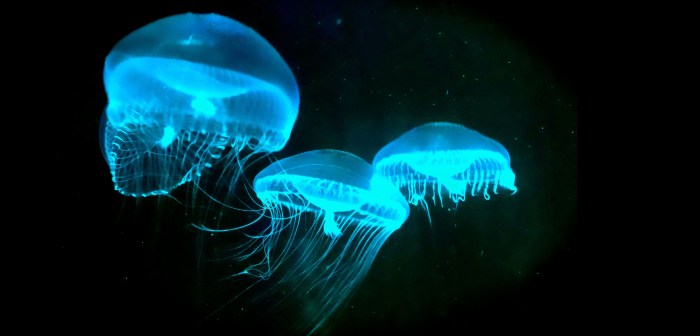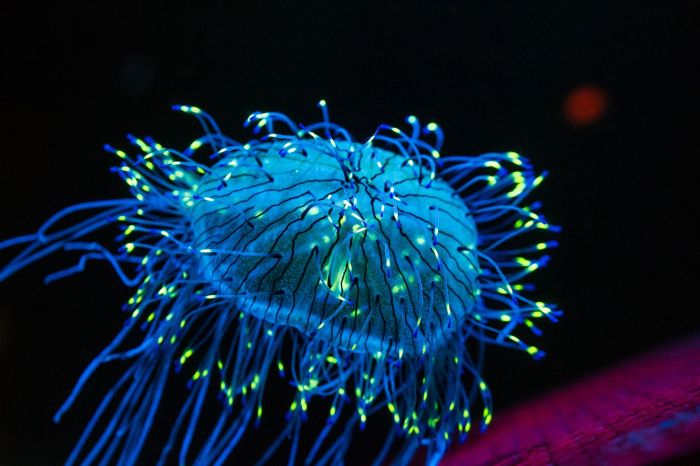Bioluminescent organisms: meet the living nightlights of our world. They are captivating creatures that illuminate the darkness with their ethereal glow. From the depths of the ocean to the terrestrial realm, bioluminescence plays a vital role in communication, defense, and ecological interactions.
These organisms possess a remarkable ability to produce light through chemical reactions, a phenomenon known as bioluminescence. The diversity of bioluminescent organisms is astounding, ranging from microscopic plankton to deep-sea fish and terrestrial insects. Their unique adaptations and behaviors have fascinated scientists and captivated the human imagination for centuries.
Bioluminescent Organisms: An Overview

Bioluminescence is the emission of light by living organisms as a result of chemical reactions. It is a widespread phenomenon, occurring in a diverse array of organisms from bacteria to fish and insects. Bioluminescence serves a variety of ecological functions, including communication, defense, and attracting prey.
Examples of bioluminescent organisms include fireflies, jellyfish, deep-sea fish, and fungi. These organisms inhabit a wide range of habitats, from terrestrial forests to the depths of the ocean. The evolutionary advantages of bioluminescence include increased reproductive success, predator deterrence, and improved foraging efficiency.
Mechanisms of Bioluminescence
Bioluminescence is a complex biochemical process that involves the oxidation of a substrate called luciferin by an enzyme called luciferase. The energy released by this reaction is emitted as light.
Different types of luciferin and luciferase enzymes produce different colors of light. For example, fireflies produce yellow-green light, while jellyfish produce blue light. The color of the light emitted is determined by the specific chemical structure of the luciferin molecule.
Bioluminescence in Communication and Defense

Bioluminescence is commonly used by organisms for communication and defense. For example, fireflies use bioluminescence to attract mates, while deep-sea fish use bioluminescence to communicate with each other in the darkness of the ocean.
Some organisms use bioluminescence as a defense mechanism against predators. For example, the deep-sea fish Melanostomias bartonbeanihas a bioluminescent organ on its head that it uses to attract prey. Once the prey is close enough, the fish will quickly consume it.
Bioluminescence in the Marine Environment

The marine environment is home to a vast array of bioluminescent organisms. These organisms include jellyfish, fish, bacteria, and plankton. Bioluminescence is estimated to occur in up to 90% of marine species.
Bioluminescence plays an important ecological role in the marine environment. It is used for communication, defense, and attracting prey. For example, deep-sea fish use bioluminescence to attract prey in the darkness of the ocean. Bioluminescence also plays a role in the food chain, as many predators rely on bioluminescence to find their prey.
Bioluminescence in Terrestrial Environments
Bioluminescence is less common in terrestrial environments than in marine environments. However, there are still a number of terrestrial organisms that exhibit bioluminescence, including fireflies, glowworms, and fungi.
Terrestrial bioluminescent organisms face unique challenges, such as the lack of water and the presence of oxygen. As a result, terrestrial bioluminescent organisms have evolved unique adaptations to produce and use light.
Human Interactions with Bioluminescence
Humans have long been fascinated by bioluminescence. Bioluminescence has been used for centuries for cultural and historical purposes, such as in religious ceremonies and festivals.
In recent years, bioluminescence has also been used in biotechnology and medicine. For example, bioluminescent proteins are used to track gene expression in cells. Bioluminescence is also being investigated for use in the development of new drugs and therapies.
FAQ Explained: Bioluminescent Organisms: Meet The Living Nightlights Of Our World
What is bioluminescence?
Bioluminescence is the production of light by living organisms through chemical reactions.
What are the different types of bioluminescent organisms?
Bioluminescent organisms include bacteria, fungi, algae, jellyfish, fish, and insects.
What are the functions of bioluminescence?
Bioluminescence is used for communication, defense, and attracting prey.